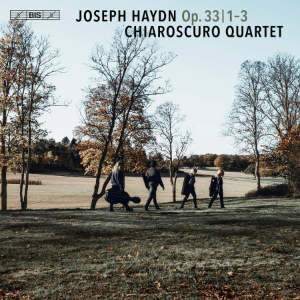
Franz Joseph Haydn (1732-1809)
String Quartets, Op. 33 “Russian”, No. 1-3 (1781)
No. 1 in B Minor
No. 2 in E-flat Major (“The Joke”)
No. 3 in C Major (“The Bird”)
Chiaroscuro Quartet
rec. 2021, Menuhin Hall, The Yehudi Menuhin School, Stoke d’Abernon, UK
Reviewed as a digital download from a press preview
BIS BIS-2588 SACD [61]
Haydn’s Op33 quartets represent one of the great watershed moments in the history of classical music. It is hard to imagine Mozart and Beethoven let alone the later Haydn without them. The art of writing large scale music out of short motives that runs through Wagner to Schoenberg and on to unlikely heirs such as Stockhausen and Boulez can be heard being born in these quartets. Unsurprisingly, they have always been popular with string quartets even if the composer’s reputation with audiences remains stuck on the condescending image of Papa Haydn. Of all the quartets working today, Op33 was always going to prove catnip to the swashbuckling Chiaroscuro Quartet.
This is Haydn playing packed with incident. No moment is allowed to pass without being underlined, sometimes in the heaviest ink. This intent to make sure the richness of Haydn’s invention is fully savoured does come at the expense of the longer term shape and momentum of movements, indeed quartets, as a whole. The opening movement of the second quartet in E flat could stand for virtually the entire set in this regard. This is ingenious music, bustling with tricks and asides. The Chiaroscuros are determined that the every last one of them will register with the listener. This reaps impressive dividends but matters such as proportion and taste matter just as much as disruption and humour even in these most bold of quartets. The onward momentum of this first movement is constantly being interrupted and the effect is a bit dislocated, jerky even. One of the great glories of the new method to writing quartets Haydn was exploring in Op33 was that sense of almost organic inevitability in the way ideas succeed one another. Too often in this movement I felt that that had been missed in favour of presenting the music as a procession of, admittedly, fabulous tricks.
And ‘fabulous’ is indeed the right word for such virtuosic playing. It may well be that such hyperactive, indeed melodramatic performances are what is needed to turn on non-believers to Haydn’s towering genius. It is certainly an exciting ride. Needless to say, the Chiaroscuros lap up Haydn’s very modern and very crunchy dissonances with their vibrato free, gut strings. I found myself wondering how many broken strings they must get through so full frontal are their assaults on their instruments. If you are looking for a set of performances that make absolute clear that these quartets are revolutionary, then look no further.
Another most welcome feature of these performances is the range of colour and effects these players draw from their period instruments. This is no ‘one size fits all’ approach to classical style. The slow movement of the third quartet – in many ways, peak Op33 – starts in a weird, husky sotto voce and Haydn’s increasingly madcap variations are meat and drink to the Chiaroscuro Quartet. The gleeful finale to the same quartet, played without any excessive point making, demonstrates just how much energy this string quartet can generate.
Taking all of these considerations into account, there is a real danger that I sound like I am damning this record with faint praise. These are stirring, challenging, brilliantly played performances but ultimately I do have some reservations that I don’t have with, amongst older favourites, the Lindsays or, turning to more recent recordings, the Doric Quartet. But it is hard not to warm to the audacity of the Chiaroscuro Quartet.
David McDade
Previous review: Lee Passarella (May 2023)
Help us financially by purchasing from





















